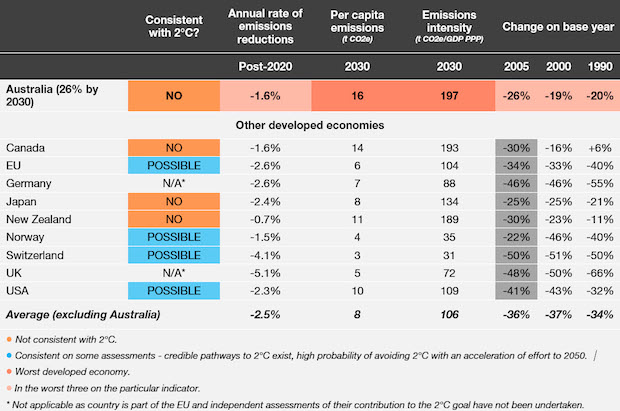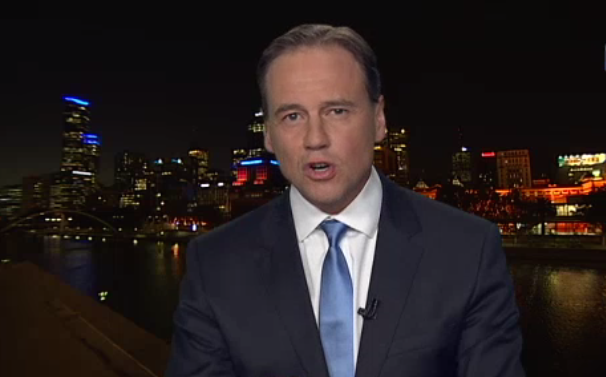Okay, so here’s the rub.
To demonstrate how desperately the Federal Government will bend the truth to justify its climate policy for the period after 2020, which was announced yesterday, New Matilda has tested three claims made by key government figures against reality.
The claims were made after a leak to The Australian the day before, at a press conference featuring Tony Abbott, Julie Bishop, and Greg Hunt.
They confirmed the government will take a reduction target of 26 per cent less emissions by 2030, measured against a base year of 2005, to crucial climate negotiations in Paris later this year.
1) Tony Abbott: “This [target]is fairly and squarely in the middle of comparable economies”
No. It’s not. It’s just not, and that’s the most important point.
The Climate Institute think tank has crunched the numbers — which is actually so much harder to do than you’d think, and much more so than the government wants you to think — to show how we compare to other economies in real terms.
Check out this graphic:

Essentially it shows that while, under an Abbott government, Australia will reduce its emissions each year at a rate of -1.6 per cent until 2030, many other economies will do so faster. The average across the countries included in the Climate Institute graphic is -2.5 per cent.
The United States will reduce their emissions at an annual rate of -2.3 per cent; the European Union at a rate of -2.6 per cent; and the United Kingdom will be kicking ass out in front, reducing their emissions at an annual rate of -5.1 per cent.
When the Prime Minister framed those numbers, he described Australia’s target as “a little below Europe [and]about the same as the United States”. Looking at the data, “a little below” and “about the same” actually mean Australia’s rate of emissions reduction in the post 2020 period will be only 61 per cent as fast as the EU’s and around 70 per cent as fast as the US’s.
Overall, we’re well and truly at the back of the pack. While for this government that might actually be viewed as a pretty good strike, it’s nowhere near enough.
According to the Climate Institute Australia would blow its ‘carbon budget’ — the portion of global emissions it can pump into the atmosphere before avoiding the two degree rise in global temperatures the international community has agreed is ‘dangerous’ — within 14 years.
Abbott did raise a good point, though, when he said our target is “almost the same as New Zealand’s”.
The trick here is that our neighbours across the ditch already draw around 80 per cent of their electricity from renewable sources.
Which brings us to a fudge the government is likely to rely heavily on to muddy the treacherous waters of international climate negotiations.
2) Tony Abbott: “When it comes to emissions per capita our reduction, at at least 50 per cent, will be the highest in at least the developed world…”
This could be true — but it’s not such a good thing. It simply goes to show we have further to go than other developed nations.
Government discussion papers leading up to yesterday’s announcement say that 95 per cent of Australia’s energy is sourced from fossil fuels. Our economy’s emissions intensity – effectively the amount of carbon emitted per unit of GDP created – is roughly twice as high as that of the United States.
We have the highest per capita emissions of any nation in the OECD. And, despite Australians making up something like 0.3 per cent of the world’s population, we are the 13th highest-emitting nation.
That puts us right behind Germany, the European Union’s highest emitting nation, which at around 80 million people has a population more than three times the size of Australia’s.
In many ways though, it should be noted, having an economy with high emissions intensity makes it easier to cut carbon. It means there are plenty of areas to look to make the changes, and the more straightforward ones can be tackled first.
3) Greg Hunt: “[Labor’s carbon tax] came in at well over a thousand dollars per tonne of abatement, whereas we produced the emissions reduction at $13.95 [per tonne]”

This one takes a bit of unpacking, but it’s important, so stick with me.
Hunt is trundling out an old claim that the government’s policy — the Emissions Reduction Fund — is more effective and cheaper than the carbon tax. New Matilda has already called Hunt out for spinning this particular bald-faced lie.
Hunt claims the government’s policy buys carbon abatement at a price more than 90 times cheaper than the carbon tax. As John Connor — the CEO of the Climate Institute — put it when the claim was first made in April, Hunt is “comparing apples and fridges”.
At that time the Australian National University’s Frank Jotzo told New Matilda that, “The most important thing to get straight in terms of misinformation and misleading comments there yesterday was Minister Hunt’s assertion that the carbon price was $1,300 per tonne.”
The price of one tonne of carbon under Labor’s ill-fated ‘tax’ was, in fact, initially fixed at $23 dollars. By now, the tax would have transitioned to be an emissions trading scheme, and would be linked to the European market, which trades at a cost per tonne of something more like $10.
Incisively, Jotzo suggested a reason why the government might be making deceptive comparisons: “[Under Abbott government policy] you have taxpayers’ money being used to pay for emission reductions rather than money coming into the Federal budget from emissions, and you have a government that makes you want to forget that taxes need to be raised or other government spending cut.”
The crux of it is that whereas the carbon tax brought in revenue, the Abbott government’s scheme forks out taxpayers’ cash to polluting companies.
It’s inherently difficult to cost the carbon tax’s net effect on the economy, but what this government is effectively doing is pretending the total amount of permits issued through the carbon tax, the total revenue raise, equates to its net effect on the economy.
The first round of the Abbott government’s ‘reverse auctions’, which involves companies bidding for government money to reward them for not generating emissions they otherwise would have, fetched a price of $13.95 per tonne of carbon.
In that first round of auctions, the government spent roughly a quarter of the $2.55 billion that’s been committed to the Emissions Reduction Fund, which provides the cash for reverse auctioneering.
Importantly, the first round of auctions only managed to buy around 15 per cent of the carbon abatement it needed to in order to meet the five per cent reduction (on 2000 level emissions) Australia has long been committed to achieving by 2020.
For a range of reasons, the price per tonne of emissions abatement at future reverse auctions is likely to be substantially higher, so it’s hard to see how Hunt’s policy can avoid blowing its budget.
When Hunt said that “we have a mechanism which produces reductions at a fraction of the cost of the carbon tax,” that was just spin.
The government’s policy requires substantial modification to prevent sectors of the economy that choose not to participate in ‘reverse auctions’ – or businesses which are unsuccessful in their bidding – from simply increasing their emissions with reckless abandon. As it stands, there’s basically no cap on carbon in the economy.
Last week one market analytics firm put it this way: “None of Australia’s top 20 emitting facilities are currently expected to incur any liability under the scheme, despite almost all being forecast to grow their emissions over the next ten years.”
When it comes to assessing the government’s claims about all these figures things get pretty complex, I know.
That’s why it’s so unfortunate that the Abbott government’s first response to probes from the press over its post 2020 climate targets makes it clear the truth will again be bent and discarded as this issue heats up heading into the next election.
Try to stick with it, though, because, you know, future of the planet and all that
Correction: This article originally stated Australia’s population made up 0.003 per cent of the global population. It is in fact 0.3 per cent.
Donate To New Matilda
New Matilda is a small, independent media outlet. We survive through reader contributions, and never losing a lawsuit. If you got something from this article, giving something back helps us to continue speaking truth to power. Every little bit counts.



